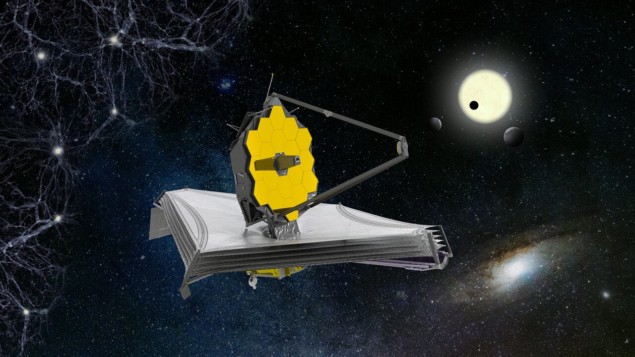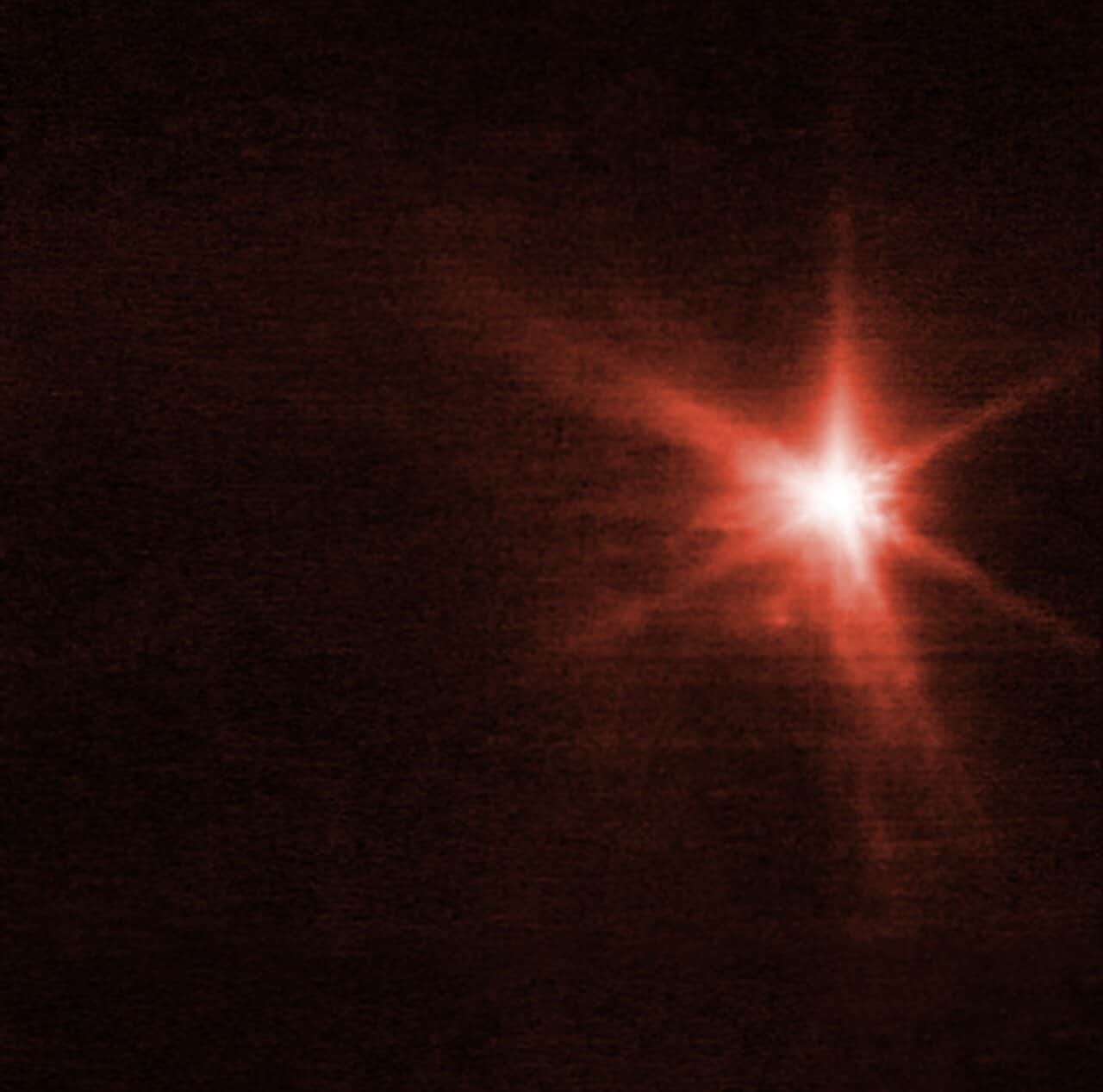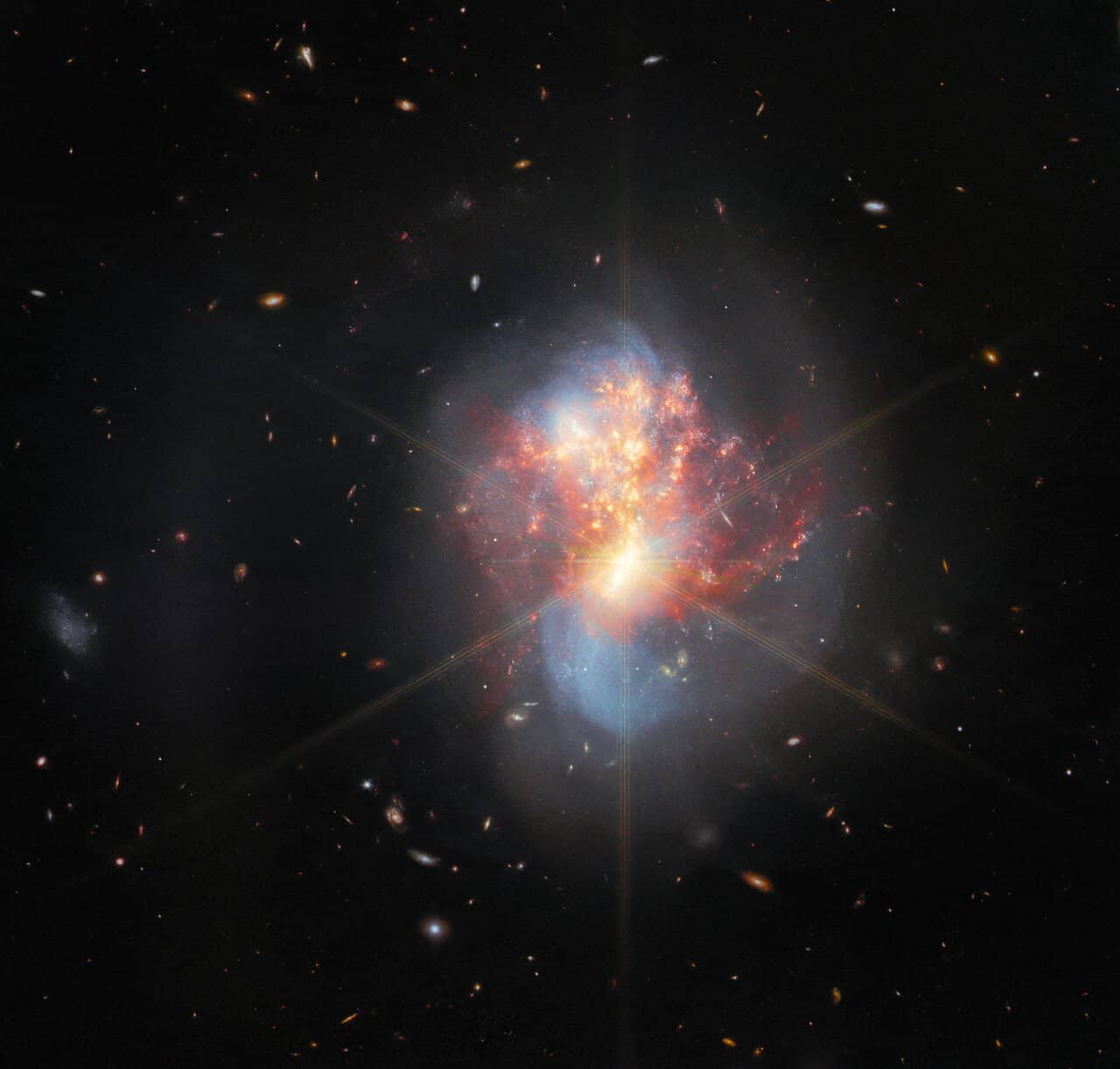A year after its launch, astronomers are revealing the secrets of the universe, as the first scientific results from observations made by the James Webb Space Telescope (JWST) are released. This month, Physics World is publishing a series of blog posts on the discoveries. This is the fourth post in the series – you can read the previous one here.

It’s been a year since the James Webb Space Telescope (JWST) launched, and after its dangerous deployment and careful collimation, it’s finally sending back incredible images and data. Getting from the launchpad to full operations, however, was no easy task. Here’s a reminder of how it all happened.
Christmas Day 2021: after nearly 25 years of development, the JWST soared into space atop an Ariane 5 rocket. Its launch was a triumph over technological tribulations, budget and schedule overruns, and even a (temporary) cancellation by the US Congress. Consequently, emotions were high as the launchpad countdown neared zero.
“It was tense,” admits Susan Mullally, the JWST’s deputy project scientist at the Space Telescope Science Institute (STScI) in Baltimore. “I couldn’t believe it was real,” adds Naomi Rowe-Gurney, a JWST GTO (Guaranteed Time Observations) postdoc at NASA’s Goddard Space Flight Center where she is supporting the Planetary Systems Team. “I was expecting another delay of some kind. I thought it was never going to launch.”
A hazardous journey
The stop–start nature of the project’s development came about in part because of the increasing complexity of the telescope, which features a segmented 6.5-metre primary mirror as well as a fragile, five-layer, tennis-court-sized insulating sunshield. Both elements had to unfold like origami after being scrunched up to fit inside the rocket faring – a 30-day process that coincided with the telescope’s journey to the L2 Lagrange point on the opposite side of the Earth to the Sun, 1.6 million kilometres from Earth.
This point is much too far away for the kind of astronaut-assisted servicing the Hubble Space Telescope received for its faulty optics in 1993. If something had gone wrong with the JWST’s mirror during its deployment, astronomers would have been left with a $10 billion white elephant floating in deep space.
“Those first 30 days were pretty nerve-wracking, because any problem was a single-point failure and would mean we wouldn’t have a telescope,” Rowe-Gurney says.
All told, there were 344 such possible points of failure: 344 points where the telescope’s intricate moving parts had to work perfectly in the cold vacuum of space. Yet work they did – “phenomenally so” according to NASA Goddard’s Jane Rigby, who spoke at the First Science Results from JWST conference held at STScI earlier this month.
“The day when I knew this was actually going to work was when that main boom swung out, and the secondary mirror folded out, and we actually had a telescope,” Rowe-Gurney says. “Even if the subsequent deployments didn’t work, we could capture light and put it into the instruments.”
Focusing the telescope
With both mirrors deployed, the next step was to focus the 18 hexagonal beryllium segments of the primary mirror. This was accomplished in seven phases. Initially, each segment produced a different unfocused image, so the first phase was to recognize which image belonged to which mirror segment. The next step was to roughly align the mirrors so that the 18 images were all in focus. After that, the segments were further adjusted so that they began to focus at the same point.
This was followed by various degrees of fine-tuning and making sure that the focus fell within the fields of view of the different instruments, and then by a series of corrections to ensure the segments were aligned to within 50 nm of each other. Finally, after a three-month process, the telescope was in focus.
Breaking the speed limit
With the telescope in good shape, the next step was to calibrate its individual instruments: the Near-Infrared Camera (NIRCam), the Near-Infrared Spectrometer (NIRSpec), and MIRI, the suite of detectors that make up the Mid-Infrared Instrument.

Distant, deep-space objects appear fixed on the sky, but objects in the solar system move against that background of stars, nebulae and galaxies. Therefore, to image planets, moons, comets and asteroids, the JWST has to track them by physically turning the spacecraft. Prior to launch, a tracking speed limit was introduced: 30 milliarcseconds per second, where one arcsecond is 1/3600th of a degree).
Once in space, however, the team realized this limit was a little pessimistic. “We were testing how fast we could track, and we realized that we could actually do much faster,” says Rowe-Gurney, who was involved in commissioning instruments for collecting data on moving targets and scattered light.
The increased tracking speed came in useful a few months later, when the JWST observed the aftermath of the DART (Double Asteroid Redirection Test) impact on the small asteroid Dimorphos. The DART mission was Physics World’s scientific breakthrough of the year for 2022, and the JWST was able to image debris ejected from its impact by tracking three times faster than the initial limit, keeping the asteroid in the field of view without blurring. Indeed, the telescope has since achieved tracking speeds of up to 120 milliarcseconds per second. However, the faster it tracks, the lower its tracking efficiency, leading to a middle-ground compromise. “In the next year the safe tracking rate will be put up to 75 milliarcseconds per second, more than doubling the speed limit, so we’ll be able to follow even more objects in the solar system without breaking the telescope,” Rowe-Gurney says.
Removing scattered light
When the JWST stares at a bright object – a planet, a star, even a distant quasar – some of the excess light forms a diffraction pattern. This pattern is the cause of the “spikes” seen around foreground stars in many of the JWST’s images, and although pretty, it can obscure scientific details. Fortunately, every telescope’s unique diffraction pattern can be described as a point spread function, and by characterizing the shape of this point spread function for the JWST and its instruments, astronomers can remove the extraneous light from images when necessary.

A case in point was the JWST’s image of the Wolf–Rayet star WR 140, which is located 5000 light-years away. When first imaged by the JWST, astronomers were stunned to see 17 concentric rings, or shells, around the star. These rings were initially thought to be imaging artefacts from the telescope, but after removing the point spread function, the rings were still there. Further investigation based on simulations showed that stellar winds from binary stars can produce rings of dust where they clash and condense. What is more, the pattern of the simulated rings precisely matched the pattern of rings around WR 140, even down to a linear feature cutting through the rings due to enhanced infrared emission in our line of sight.
The observations of WR 140 represent the first time a colliding wind structure around a binary star has been mapped in 3D. But if astronomers had not first modelled the pattern of scattered light leaking into the telescope so they could remove it, it would have been impossible to discern what the observations were telling us.
Astronomers’ new toy
The Wolf–Rayet star example shows how vital it is to get to know the telescope while making observations. “It’s something you have to think about a lot,” Mullally says. “Every step of the way you’re hoping to have an expert on your team who knows as much as possible either about the instrument or about how those types of observations are taken.”

Accordingly, one of the motivations behind the JWST’s Early Release Science (ERS) was to help a few astronomers become familiar with the telescope and its instruments so they can bring others up to speed for later observing cycles. “It’s like a new toy,” says Rowe-Gurney. “There’s a lot of work going into how to process and calibrate the data to make sure it’s reliable.”
Fortunately, the JWST is playing ball. “Instrument scientists might say they are still getting to know their instruments and how to go about removing little systematics and artefacts and things like that in your data,” says Mullally, “but overall the impression I’m getting from everybody is that the telescope is performing wonderfully.”
Impact risk
So far, there is only one caveat to the JWST’s performance: the damage caused by micrometeoroid impacts. On average, the telescope’s mirror is struck once a month by something large enough to affect wavefront sensing, which is the telescope’s ability to detect errors in the alignment its optics that can manifest as light waves going out of phase. This reduction in wavefront sensing can make images less sharp.
Such impacts were anticipated before launch, and were not expected to be big enough to threaten the telescope’s lifespan. However, in May 2022 one of the mirror segments received a larger-than-typical impact. In her talk at the First Science Results from JWST conference, Rigby reported that this impact left a wound a foot across, increasing the telescope’s total wavefront error by 9 nm. This is significant because if the wavefront error reaches 150 nm, the telescope will no longer be sensitive enough to meet its scientific targets – meaning that just 10 impacts of a similar scale would be “game over” for the JWST.
Somewhat alarmed by this prospect, NASA has convened a micrometeoroid working group to investigate the risk. The micrometeoroid population at L2 is well known; what isn’t clear is the relationship between the kinetic energy of impacts and the degradation of wavefront sensing. Are such large impacts extremely rare and the JWST was simply unlucky in May? Or will the telescope experience more serious impacts at a greater frequency than predicted?

Quasars, exoplanets and the atmospheres of distant worlds: more on the first results from the JWST
Until the working group comes up with answers, the telescope’s managers are mitigating the risk by encouraging astronomers to time their observations (where possible – time-sensitive observations are exempt) so that the telescope is not pointing into the “rain” of micrometeoroids.
If this system succeeds, or the working group comes up with a reassuring answer about impact odds, the JWST should have a long life ahead of it. Thanks to its flawless launch and a journey to L2 that required minimal course corrections, the scope has enough propellant on board to continue its mission for at least another 27 years. If the mission’s first 12 months are any indication, these 27 years should produce reams of sensational new views and data from a superb instrument, with a high likelihood of transforming astrophysics, exoplanet studies, cosmology and more. The rollercoaster ride of the JWST’s launch may be over, but the real journey is just beginning.



